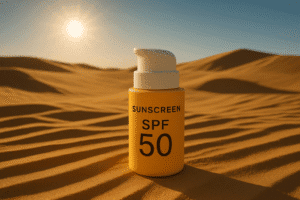Benefits, Types, And How To Use It Right
 In India, the sun shines throughout the year, due to which our face faces many types of problems that arise from the rays of the sun. The sun’s UV rays are not visible to the human eye, but they can cause tanning, dark spots, early aging, and even serious skin problems over time.
In India, the sun shines throughout the year, due to which our face faces many types of problems that arise from the rays of the sun. The sun’s UV rays are not visible to the human eye, but they can cause tanning, dark spots, early aging, and even serious skin problems over time.
That’s why sunscreen isn’t just a “collection-to-have”—it’s a necessity for everyone, no matter what your skin type or skin tone.
In this blog, we’ll talk about why sunscreen is so important, the different types you can choose from, how to use it the right way, and an easy guide to finding the perfect one for you. Let’s make sun protection important and simple!
⦁ Benefits of sunscreen
Using sunscreen on a daily basis isn’t just about avoiding sunburn or sun rash — it’s about keeping your skin healthy, fresh, and glowing in the long run and preventing aging. Here’s why sunscreen should be your skin’s best friend:
1. Keeps Your Skin Looking Young:
Sunscreen helps prevent harmful sun rays(UV rays) and slow down the early signs of aging like wrinkles, fine lines, and sagging skin.
2. Protects You From Serious Damage:
Regular use of sunscreen protects from UVA and UVB rays–both of which can cause serious health problems like skin cancer, sunburn. It’s a small step that can make a big difference for your health.
3. Helps Fade Dark Spots and Pigmentation:
“If you spend a lot of time outdoors, you may have a risk of hyperpigmentation, dark spots, or uneven patches, sunscreen is a must. It helps prevent these spots from getting darker and supports a more even, smooth skin tone over time.
4. Reduces skin inflammation:
The harmful rays of the sun can damage the cells that protect our skin, causing inflammation and releasing harmful molecules called free radicals. This can be even harder for people with sensitive or redness-prone skin. Wearing sunscreen every day helps protect your skin and keeps inflammation under control.
⦁ Types of sunscreen
It is relevant to know about how different categories of sunscreens work. Perfectly, sunscreens should incorporate active ingredients which develop protective filters for UV and guard against undesirable sun rays penetration inside the skin.
There are two categories of active ingredients in sunscreen (also referred to as UV filters) that can protect your skin from the sun’s rays: physical barriers (mineral sunscreen) and chemical barriers (chemical sunscreen). To make the right sun protection choice for your skin and your lifestyle, it’s helpful to know what differentiates these two.
When it comes to safeguarding your skin from the damaging rays of the sun, there are two forms of sun filters to pick from: chemical sunscreen and mineral sunscreen
WHAT IS CHEMICAL SUNSCREEN?
chemical sunscreens are organic and chemically react to UV exposure. They are absorbed into the skin and then absorb UV rays, it transforms the rays into heat and releases the heat out of the body. The chemicals trap the rays within their structure, and therefore, the skin itself is not influenced directly by the sun’s radiation, but through trapping or concretizing this radiation into chemical molecules, the molecules become teeny nuclear powerhouses. Some active ingredients used in chemical sunscreens are avobenzone, octinoxate and oxybenzone.
WHAT IS MINERAL SUNSCREENS?
Mineral sunscreens, also known as physical sunscreens, contain ingredients such as zinc oxide and titanium dioxide, which physically block or scatter the sun’s UV rays. These minerals create a physical barrier on the skin that reflects and scatters the UV radiation away. This prevents sunburn and damage to the skin. Mineral sunscreens are broad-spectrum protectors, photostable, and do not absorb much into the skin.They are typically fine for sensitive skin and are frequently hypoallergenic.
WHAT IS A HYBRID SUNSCREEN?
Hybrid sunscreens blend both mineral and chemical sun filters into one sunscreen product to provide the advantages of both. They take the best of mineral sunscreen and marry it with the cosmetic beauty usually associated with chemical sunscreens. This results in a sunscreen product that is light and easily blends on all skin types, without any white residue.
⦁ How to use sunscreen right
It is as crucial to use sunscreen correctly as it is to select the proper one. In order to receive maximum protection, you must put on the right amount, put it on at the right moment, and not forget to reapply. Here’s precisely how to do so:
⦁ How much to apply
⦁ For Face, Neck, and Ears:
⦁ 2-Finger Rule: Compress sunscreen along your middle and index fingers — whole length.
⦁ ¼ Teaspoon Rule: Apply about ¼ teaspoon sunscreen to your face alone.
⦁ For the Body:
⦁ Apply around one shot glass (about 1 oz or 30 ml) to cover the entire body.
⦁ Why It Matters:
⦁ Not using enough decreases SPF performance.
⦁ Sunscreen needs to create an even layer to effectively shield your skin.
⦁ When to Apply
1. Morning Application:
⦁ Use sunscreen after your regular morning skin care routine, which should involve cleansing, moisturizing, and applying any serums or treatments.
⦁ Make sure you apply it a minimum of 15-30 minutes prior to going outside to enable it to penetrate into your skin.
2. Reapplication:
⦁ Reapply sunscreen every two hours, particularly if you are sweating, swimming, or doing any water activities.
⦁ Even on cloudy days, it’s important to reapply sunscreen to maintain protection.
⦁ Reapply sunscreen even if you are outside or inside.
3. Key Things to Consider:
⦁ Sunscreen is to be the last step in your skin care procedure prior to applying makeup.
⦁ In case you are using makeup, let the sunscreen set completely before applying makeup products.
⦁ Even if you happen to be inside, application of sunscreen is advised as UV rays may pass through glass.
⦁ Where to Apply
Apply sunscreen to all exposed areas, not only the face:
⦁ Face and Neck (including chin)
⦁ Ears (tops and behind them)
⦁ Hands (especially backs)
⦁ Arms and Legs
⦁ Feet (if in open shoes)
⦁ Hairline and scalp (if hair is thin or part exposed)
⦁ Tips for Layering with Makeup or Moisturizer
⦁ Moisturizer first, sunscreen next, then makeup.
⦁ Allow moisturizer to dry completely before putting on sunscreen.
⦁ Select a sunscreen that layers nicely without pilling (search for “makeup-friendly” or “primer-like” sunscreens).
⦁ Apply setting sprays with SPF or cushion compacts with SPF for easier reapplication over makeup throughout the day.
⦁ Never depend on makeup with SPF only — it’s not typically enough protection.
⦁ Best sunscreen guide
⦁ How to Choose the Best Sunscreen
⦁ SPF 30 vs. SPF 50: SPF 30 guards against 97% of UVB rays for daily use. SPF 50 guards against 98% — ideal for extended sun exposure, sensitive skin, or sunny climates.
⦁ PA+++ vs. PA++++: PA+++ offers strong UVA protection; PA++++ offers extremely high protection for people who are bound to develop pigmentation.
⦁ Non-comedogenic: Apply non-comedogenic sunscreens if your skin is prone to acne.
⦁ Key Ingredients:
Zinc Oxide & Titanium Dioxide: Gently, broad-spectrum protection.
Niacinamide: Soothes redness and fortifies skin.
⦁ Avoid: Alcohol and Oxybenzone, irritating sensitive skin.
⦁ Application Tips
⦁ Apply as the last step of skincare before makeup.
⦁ Reapply every 2–3 hours, with sprays or powders for makeup-permitting reapplication.
⦁ Use sunscreen indoors or on cloudy days, since UV rays can penetrate.
⦁ Extra Protection
⦁ Wear hats, sunglasses, and apply Vitamin C for extra protection.
⦁ Cleanse thoroughly at night to prevent clogged pores.
⦁ Common sunscreen mistake to avoid
⦁ Not reapplying sunscreen
⦁ Skipping sunscreen on cloudy days
⦁ Skipping sunscreen on cloudy days
⦁ Skipping proper amount of sunscreen
⦁ Applying old leftovers
⦁ Assuming dusky skin doesn’t need sunscreen
⦁ Omitting sunscreen application at home
⦁ Forgetting to wear sunscreen under makeup
⦁ Ignoring your skin type
Conclusion:
Make Sunscreen Your Skincare Essential
Sunscreen is a vital step in any skincare routine, protecting your skin from harmful UV rays that contribute to premature aging, sunburn, and even skin cancer. It’s essential to develop a daily sunscreen habit and avoid common mistakes like skipping it on cloudy days, not reapplying, using expired products, or assuming darker skin doesn’t need protection. Always apply the proper amount of sunscreen and remember that it’s not just for when you’re outdoors — even indoor exposure to sunlight or blue light can affect your skin.
Make sunscreen your year-round essential for maintaining a youthful glow and healthy complexion. Share this guide with friends and family to help them protect their skin too. Don’t forget to try a new SPF today and safeguard your skin’s future!

